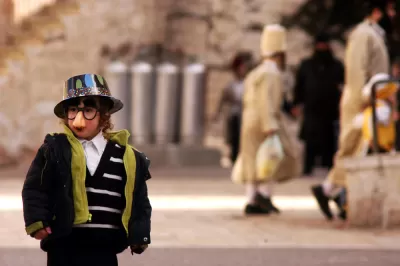A little pre-Purim humor (well, attempted humor anyway).

The Jewish holiday of Purim is this week—one of the few Jewish holidays that are actually more fun than solemn. On a related note, the University of Chicago has an annual tradition of the Latke-Hamantash debate. In these "debates," scholars try to make arguments (preferably ridiculous ones) about whether the latke (a potato pancake commonly eaten by Jews during Chanukah, a holiday that usually occurs in December) or the hamantash (a pastry commonly identified with Purim) is better. This year, a question occurred to me: Is there an urbanist way to do a latke-hamantash debate?
If I had thought of this a few weeks ago, maybe I would actually structure one. But since I didn’t, I’ll just try to do at least one side of the debate in print. So here is my intentionally silly urbanist case for the hamantash:
*There are three key factors in making a neighborhood walkable: density (because dense places are more walkable), diversity (of land uses, so people can walk to shops, parks etc), and design (for example, too-wide streets are dangerous for pedestrians). Similarly, a hamantashen is triangular, which means it has three points. Coincidence? Maybe, but what about...
*Sugar vs. starch. Latkes are made of potatoes, which means that they are basically boring—like the rural areas in which potatoes are grown. Hamantashen are more fun, like cities: they are full of sugar and fruit flavors, as well as the starchiness of baked wheat. And because hamantashen are not exactly an all-natural food, they require the economic growth that goes along with urbanization. Market urbanists in particular should favor the complexity of the hamantash over the simplicity of the latke. Eco-socialists fear economic growth, and hope to limit mankind to subsistence foods like potatoes, while only the free market could create the hamantash's intricate mix of flavors.
*The story of Purim is more "urban" than the story of Chanukah. Chanukah is all about a rebellion that begins in a small town in Israel. Purim is about palace intrigue in the city of Shushan, at the heart of the ancient Persian Empire.
*Purim ideally involves drinking alcohol, which is obviously much easier in a walkable big city than in suburbs where driving is usually necessary and drinking is therefore far more dangerous.
Does anyone want to make the urbanist case for latkes?

Montreal Mall to Become 6,000 Housing Units
Place Versailles will be transformed into a mixed-use complex over the next 25 years.

Planetizen Federal Action Tracker
A weekly monitor of how Trump’s orders and actions are impacting planners and planning in America.

DARTSpace Platform Streamlines Dallas TOD Application Process
The Dallas transit agency hopes a shorter permitting timeline will boost transit-oriented development around rail stations.

Chicago Transit: $770M Shortfall, 40% Service Cuts Loom
Despite dire warnings from transit officials, the Illinois General Assembly ended its legislative session without a solution.

Without International Immigrants, the Rural US Population Would Be Falling 58%
Census data shows that population growth in rural areas is due in large part to international migrants.

Dead End: Nine Highways Ready for Retirement
The Freeways Without Futures report describes the nation’s most promising highway removal proposals.
Urban Design for Planners 1: Software Tools
This six-course series explores essential urban design concepts using open source software and equips planners with the tools they need to participate fully in the urban design process.
Planning for Universal Design
Learn the tools for implementing Universal Design in planning regulations.
City of Mt Shasta
City of Camden Redevelopment Agency
City of Astoria
Transportation Research & Education Center (TREC) at Portland State University
City of Camden Redevelopment Agency
Municipality of Princeton (NJ)
Regional Transportation Commission of Southern Nevada



























